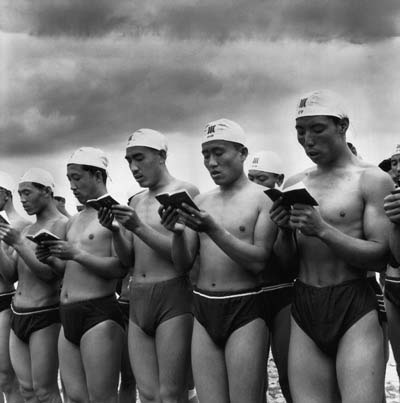 © Li Zhensheng, 1966, Contact Press Images (1966) Li Zhensheng Red-colour New Soldier: A Chinese Photographer's Odyssey through the Cultural Revolution "Now we have to hold high the great banner of the Proletarian Cultural Revolution... we must thoroughly criticise bourgeois reactionary thinking in the academic field, the media, publishing and the arts, and seize the power of leaders in the cultural arena" (*1). In 1965 Mao issued this rallying cry which was to begin the Great Proletarian Cultural Revolution, an internal war which raged across China for a decade between 1966 and 1976. These were times when child turned against parent and pupil against teacher; tens of thousands of young revolutionaries were mobilised as Red Guards, while countless others were executed, imprisoned or sent to work camps accused of being enemies of the masses. The photographer Li Zhensheng, spent almost 20 years from 1963 working for the Heilongjiang Daily, a Communist newspaper in Northern China. His unique archive of images conveys the madness of this time - its spectacular, stage-managed public trials, its recantations, its cult of personality, its mass demonstrations, its executions and its re-education campaigns – as seen through the eyes of an exceptional witness. Li, born in August 1940, was initially full of revolutionary zeal and committed to Mao's cause. He set up his own group of revolutionaries on the newspaper called "Red Youth Fighting Team". They won official recognition from Beijing, and were sent red armbands inscribed with an ideogram from Mao translated as "red-colour news soldier" (i.e. "revolutionary journalist"). The exhibition brings together over 130 of his photographs, along with personal documents, divided into chronological sections from the Socialist Education Movement in 1964 - 65 to the years leading up to Mao's death in 1976. Li fell victim to bitter political infighting and in 1968 was accused of being "petit-bourgeois" and a "foreign agent". At the end of 1969 he was sent to a "re-education school" in a desolate rural region north of Harbin for two years. He returned to work in 1972 as head of photography at the Heilongjiang Daily, a position he maintained until 1980. At great personal risk, he hid and preserved thousands of photographs in his furniture and under his floorboards. Today, these pictures form the only known existing photographic documentation of the period, from Zhensheng's unique eye. As is stated in a recent comprehensive book on his work: "Li Zhensheng was tracking human tragedies and personal foibles with a precision that was to create an enduring legacy not only for his contemporaries but for the generations of his countrymen then unborn..." (*2) Exhibition conceived and curated by Robert Pledge, Director of Contact Press Images (New York/Paris). Co-produced and presented by Patrimoine Photographique-Ministry of Culture, France. 1* Mao Zedong in a circular, May 16, 1965. From Maria Galikowski Art and Politics in China 1949 - 1984, Chinese University Press, 1998 2* Jonathan D. Spence in his introduction to "Red-Color News Soldier", edited by Robert Pledge written by Jacques Menasche, Phaidon Press Limited 2003 Programme Organiser: Camilla Jackson Exhibition: 8 April - 30 May 2004 Gallery hours: Mon-Sat 11 am - 6 pm, Sun noon - 6 pm The Photographers' Gallery 8 Great Newport Street UK-London WC2H 7HY Telephone +44 020 7831 1772 Fax +44 020 7836 9704 www.photonet.org.uk |